Tom's Hardware Verdict
HyperX’s first pair of true wireless gaming earbuds sound pretty good, if you can get them to connect to your device.
Pros
- +
Good spatial audio
- +
2.4 GHz wireless dongle with PC adapter
Cons
- -
Trouble connecting properly
- -
Unintuitive controls
- -
Bulky and otherwise generic-looking
Why you can trust Tom's Hardware
There’s nothing quite as freeing as a pair of wireless headphones — or, that’s what I used to think, until I tried a pair of true wireless earbuds.
I’m not kidding — there are a lot of situations where cutting that last wire has had a surprisingly significant effect. I no longer get wires caught under the barbell when I’m doing squats at the gym, for example. I also don’t have to worry about getting tangled up when I’m putting on/taking off outerwear or bags. (That’s not to say they don’t present new problems — my Airpods fly out of my ears and ping pong across the floor every single time I remove a mask, no matter how cautious I am.)
True wireless earbuds are much more convenient than I expected they would be, but there are still a handful of situations in which I’m not convinced they’re necessary (or even useful). Gaming, for example — and not just because of reliability and latency concerns often associated with wireless peripherals, but because gaming isn’t an activity where you’d normally reap much benefit from the flexibility and freedom of movement true wireless earbuds offer.
But this hasn’t stopped companies such as Razer and EPOS from coming out with gaming-oriented true wireless earbuds. And now HyperX has dropped its first pair of true wireless earbuds aimed at gamers (and also everyone), the HyperX Cloud MIX Buds.
The HyperX Cloud MIX Buds have dual-mode wireless connectivity for all of your gaming and non-gaming needs. The Cloud MIX Buds offer a low-latency 2.4 GHz wireless connection (via included USB-C dongle) for gaming on PC, PlayStation, and Switch, as well as built-in Bluetooth 5.2 for mobile devices and multimedia. Unlike some higher-end headsets, these earbuds can’t use both connections simultaneously, but the 2.4 GHz wireless dongle does have a dedicated button for quickly switching between modes.
Oh – but if you’re thinking, no wires, no problems, think again. True wireless earbuds should make your life easier and more convenient, but I’d happily take a wired headset with extra wires after all of the connection issues I faced while testing these. The HyperX Cloud MIX Buds are on sale now for $149.99, and they might be worth a look in the future, but only if the company fixes these problems with a firmware update.
Specs for HyperX Cloud MIX Buds
| Driver Type | 12mm dynamic |
| Impedance | 32 Ohms |
| Frequency Response | 10 Hz = 20.4k Hz |
| Design Style | True Wireless Earbuds |
| Microphone Type | Omni-directional, 50 Hz - 6.7k Hz |
| Connectivity | 2.4 GHz, Bluetooth 5.2 |
| Weight | 11g (each earbud), 36.5g (charging case), 32g (silicone sleeve) |
| Cord Length | N/A |
| Battery Life | 21 - 33 hours, including case (6 - 10 hours without case) |
| Lighting | N/A |
| Software | HyperX NGENUITY |
Design and Comfort of the HyperX Cloud MIX Buds
HyperX’s Cloud MIX buds will look familiar to anyone who’s seen a pair of true wireless earbuds — there’s nothing particularly unique or noteworthy about the design. The earbuds themselves are stemmed, and have a curvy, angled shape that fits snugly in your ear canal and offers decent passive noise cancellation. Each earbud has a small touch sensor on the stem (above the HyperX logo), which can be configured using HyperX’s NGENUITY app/software.
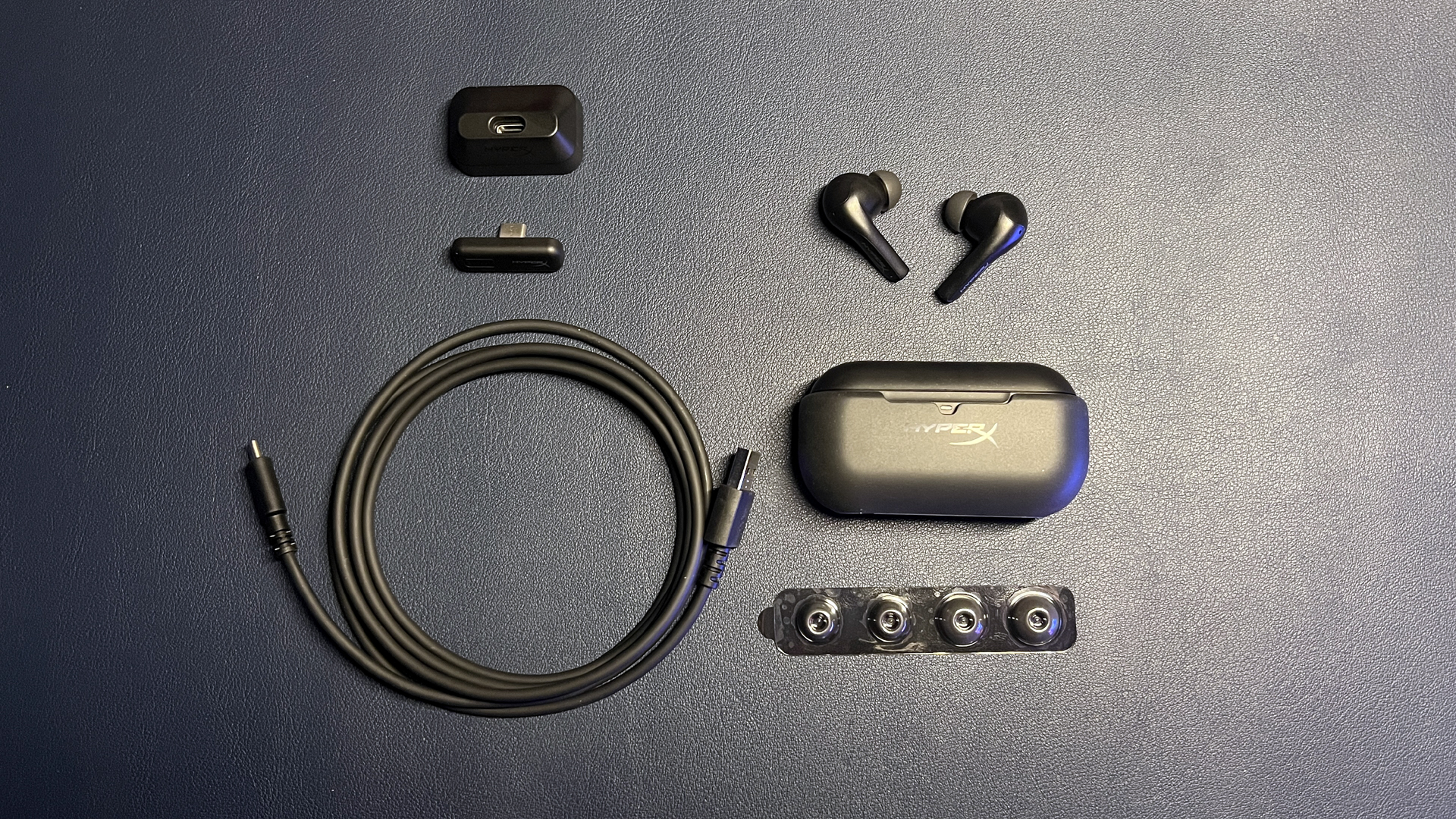
In the box, you’ll find the earbuds in a wireless charging case, which has a magnetic snap closure and comes cradled in a protective — but somewhat bulky — silicone sleeve. You’ll also find a 2.4 GHz wireless USB-C dongle, a USB-C to USB-C adapter, a USB-C to USB-A charging cable, and two additional sizes of silicone eartips.
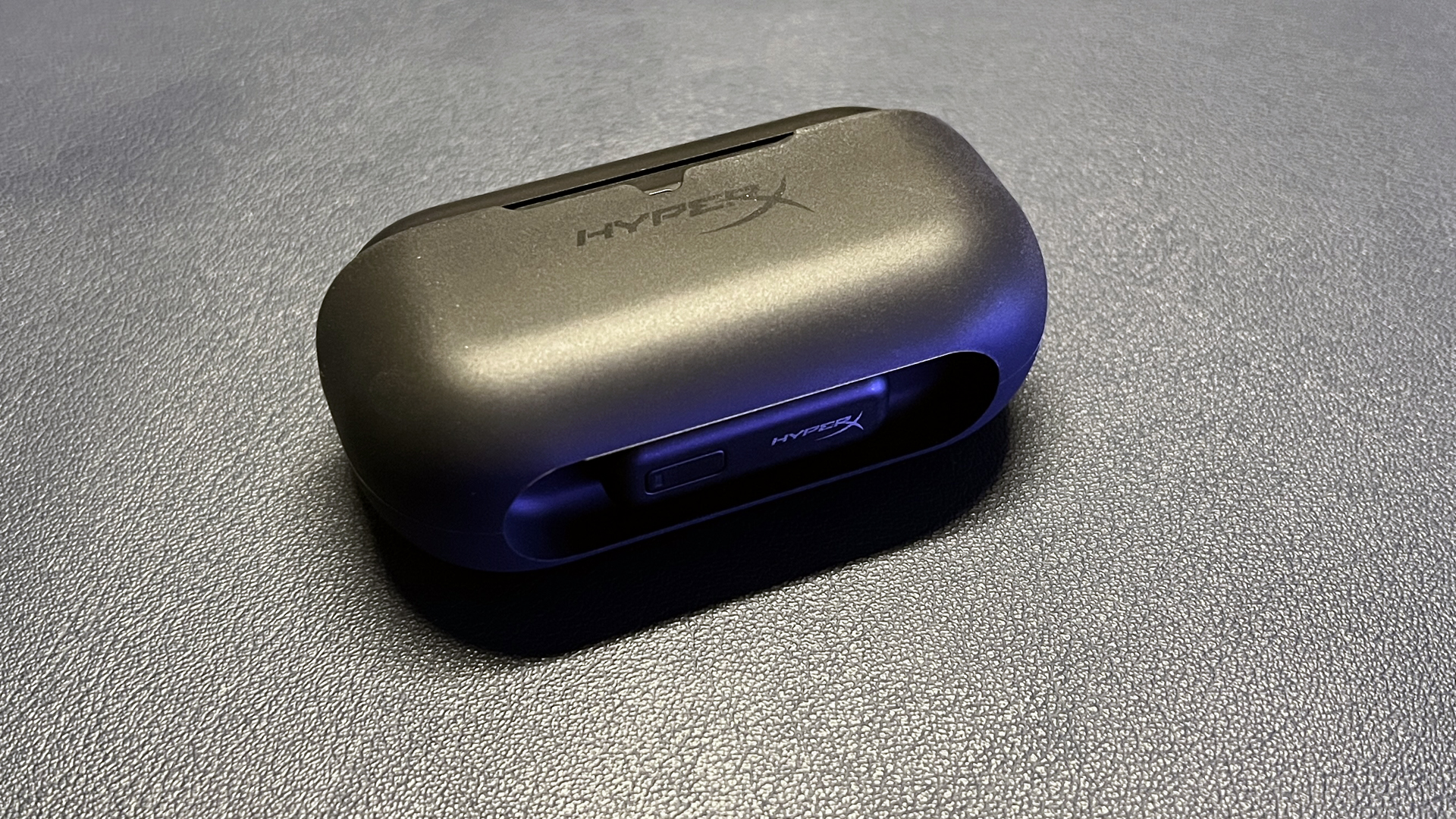
The silicone sleeve is designed to give you a spot to store the wireless dongle when you’re not using it — the USB-C port on the bottom of the charging case, which might be handy for traveling.
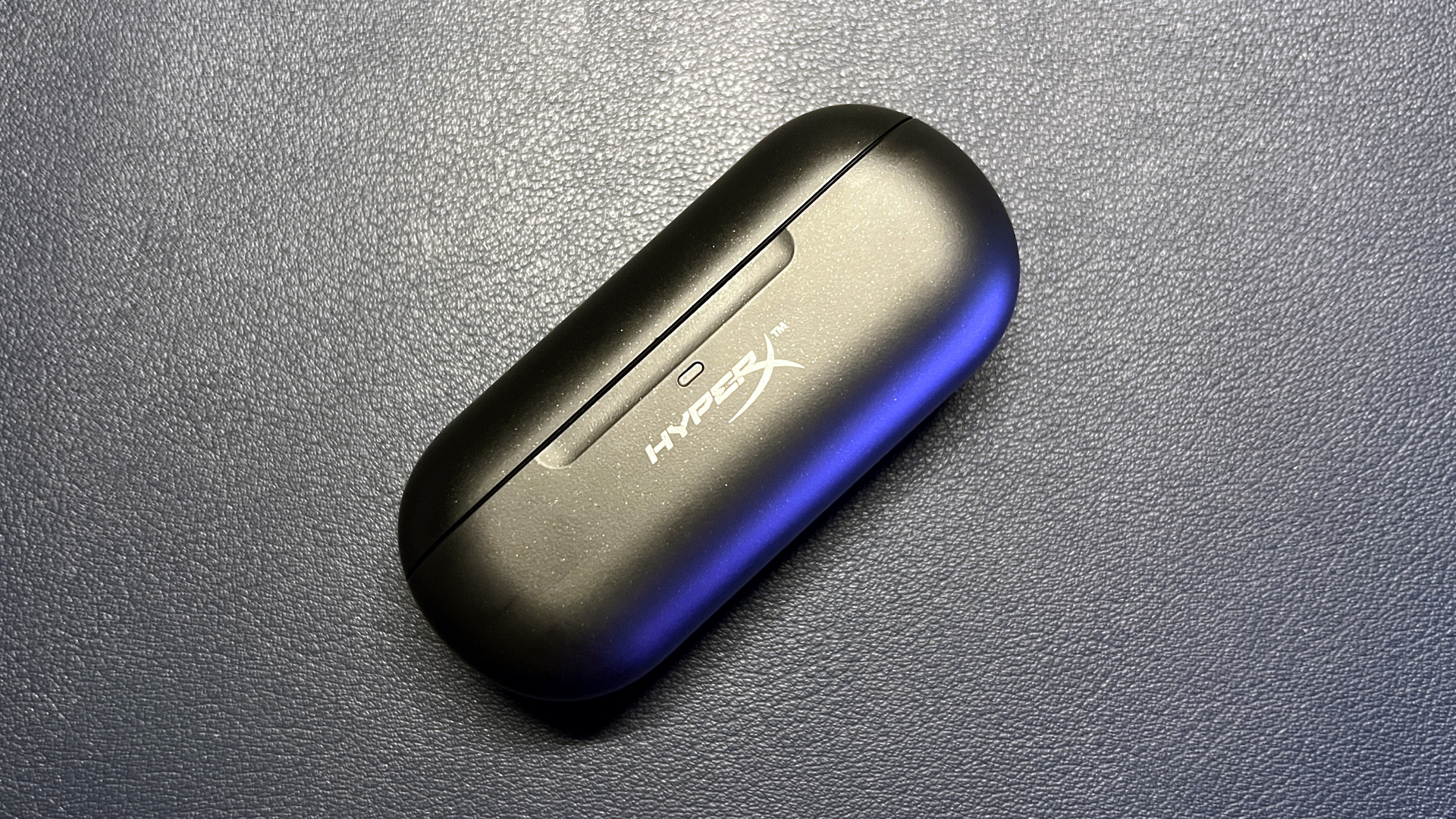
But it does add a lot of extra heft to the charging case, and it’s not particularly attractive (in my opinion). Plus, you can always store the wireless dongle in the desktop adapter, which looks like a docking port for the dongle anyway (albeit a tiny one, so this might not be too practical if your goal is to not have to keep track of a bunch of small pieces).
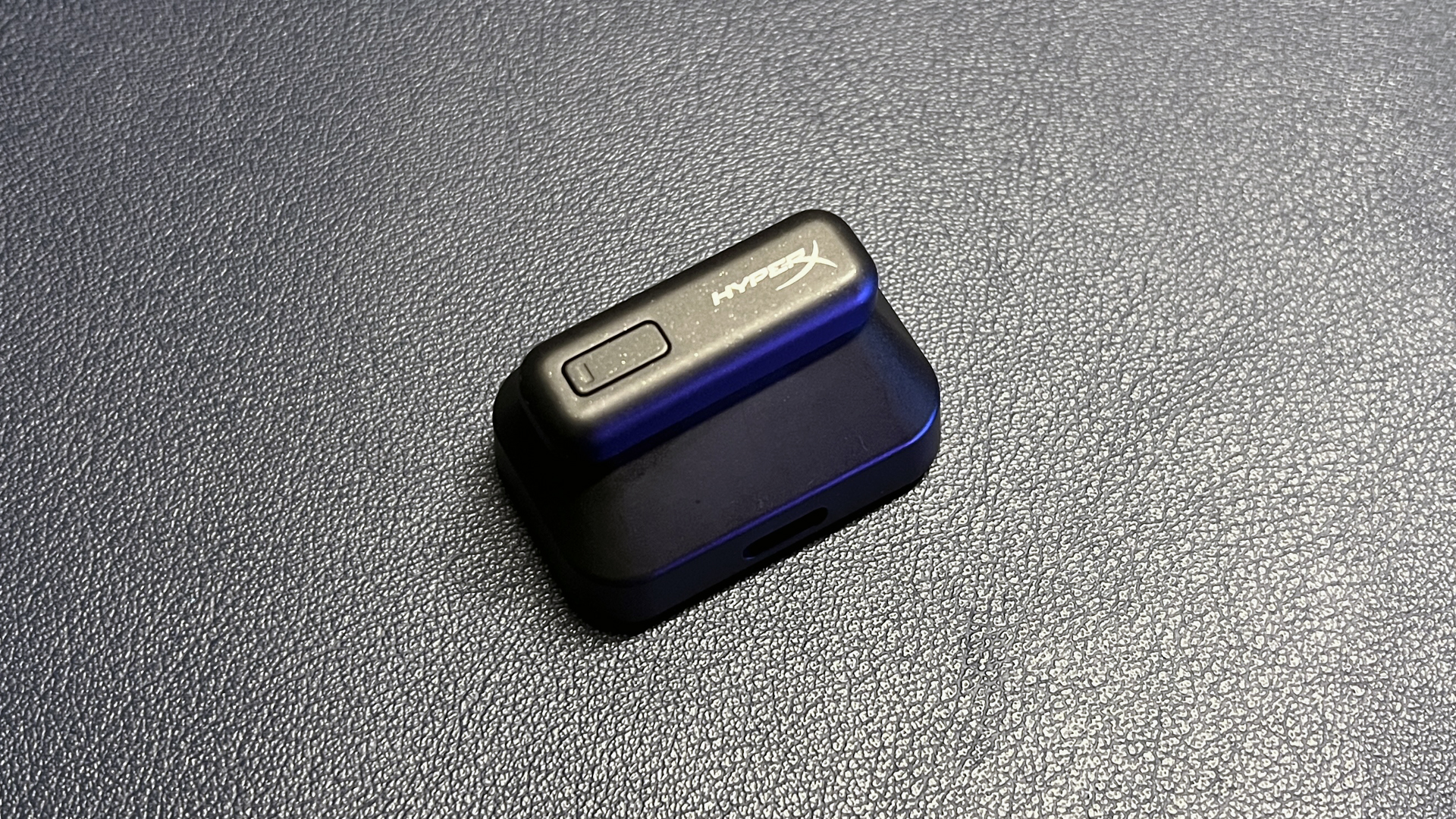
As far as we know, the Cloud MIX Buds will only come in one colorway, which is black. If you look closely at the pictures, you’ll notice the earbuds, charging case, and wireless dongle all feature a subtle glitter effect. (It’s much more subtle in person, though — trust me, these are just black.)
The Cloud MIX Buds have a lot of buttons and controls for how generic they otherwise look. The charging case has a single multi-purpose button on the back, which is used for Bluetooth pairing and checking the case’s battery level. The wireless dongle has a dedicated mode button, which you can use to switch between wireless and Bluetooth connections (the earbuds prioritize 2.4 GHz wireless mode when it’s in range, but you can use this button to force switch to Bluetooth).
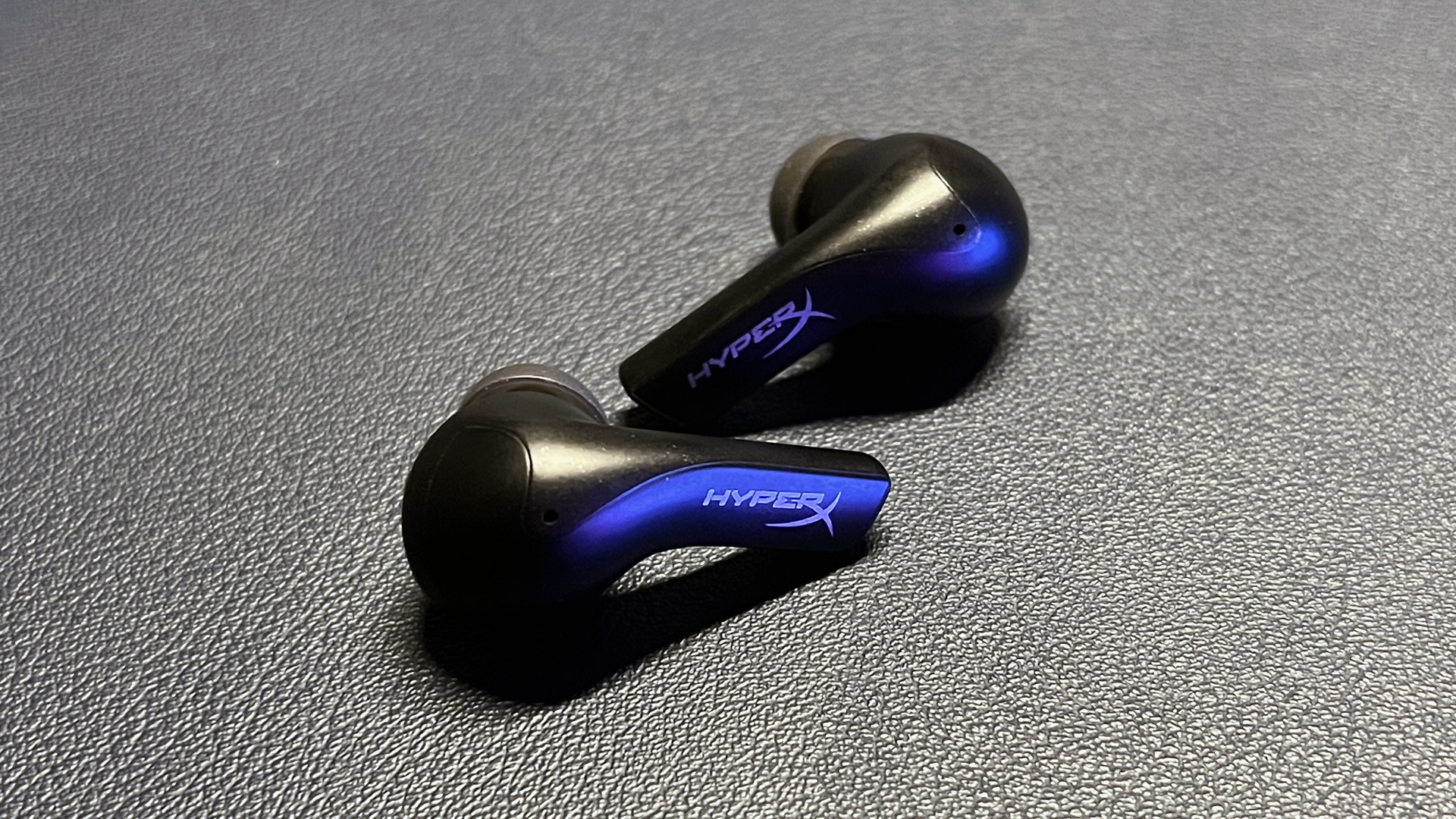
The earbuds don’t have buttons, but they do have touch sensors for easy multimedia control. The default settings are similar to what you’d expect (tap once to play/pause, tap twice to skip a track, etc), and can be customized using the HyperX’s companion app, NGENUITY.
These are in-ear earbuds with silicone tips. My ears aren’t particularly small — they’re solidly medium-sized — and these earbuds were just a little too large to feel comfortable right away. They didn’t hurt, and they weren’t falling out, but they felt overwhelming in my ears. I grew more accustomed to them after a couple of days, but even now they’re still slightly-too-big-to-be-comfortable. Largeness aside, the earbuds fit my ears pretty well, creating a decent seal that offered good passive noise cancellation.
Audio and Mic Quality on the HyperX Cloud MIX Buds
Before I get into audio quality, let me mention what a difficult process it was to even get to a point where I was able to assess audio quality.
There are two ways to connect the Cloud MIX Buds to a device: 2.4 -GHz wireless and Bluetooth. Both are fairly straightforward — the wireless dongle is already paired to the earbuds, so all you should have to do is plug the dongle in and the earbuds will automatically connect when you remove them from the charging case.
For Bluetooth, you’ll need to long-press the button on the charging case while the earbuds are in the case and the case is open. The LED on the charging case will flash blue when you’re in pairing mode, and then all you have to do is pair the earbuds to your device. This probably seems pretty simple and straightforward, especially if you have any experience with wireless earbuds/headphones/anything.
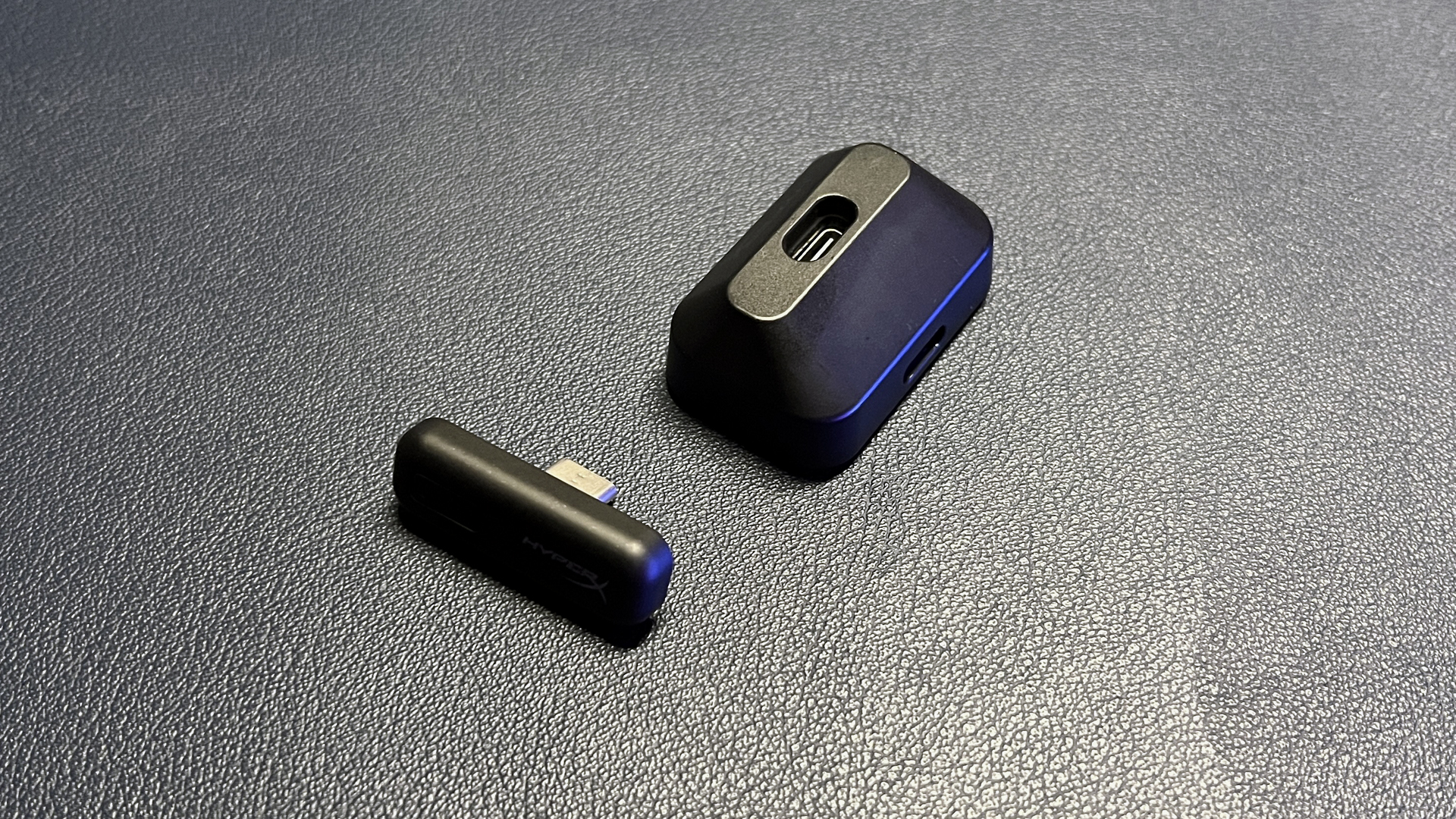
I started with the 2.4-GHz wireless dongle, which I plugged into my PC using the adapter (the dongle plugs into the adapter, and the USB-C to USB-A charging cable plugs into a USB port on your PC). I opened the Cloud MIX Buds, and they successfully paired to the dongle — or so I thought. I then had an online meeting to attend, and it was at that point I discovered that the microphone wasn’t working.
I went into my audio settings and everything seemed fine — I could see the earbuds in both output and input — so I did some troubleshooting but nothing seemed to work. (At that point I just swapped headsets to take the meeting, but I came back later and tried everything: Uninstalling all connected devices, unplugging everything, updating Windows, updating all drivers, updating the BIOS…)
I decided to table the 2.4-GHz connection for the moment and try connecting to my iPhone 13 Pro using Bluetooth. I put the Cloud MIX Buds in pairing mode and they popped up on my iPhone — I tapped, and they paired instantly! I pulled up my test playlist on Spotify and took my dogs on a 15-minute walk. When I got back, I took the earbuds out of my ears and set them down for about five minutes. When I picked them up they had unpaired from my phone, so I found the case to re-pair them, only to get an error message seven times in a row.
I’m pretty sure I experienced every connection issue that exists during my testing period. At one point, I connected to a laptop using Bluetooth and the laptop only seemed to recognize the Cloud MIX Buds’ microphone — but I could hear music through the earbuds, only it sounded extremely compressed. I also tried to switch from 2.4-GHz mode to Bluetooth mode using the mode button on the wireless dongle, and ended up with just static in one ear.
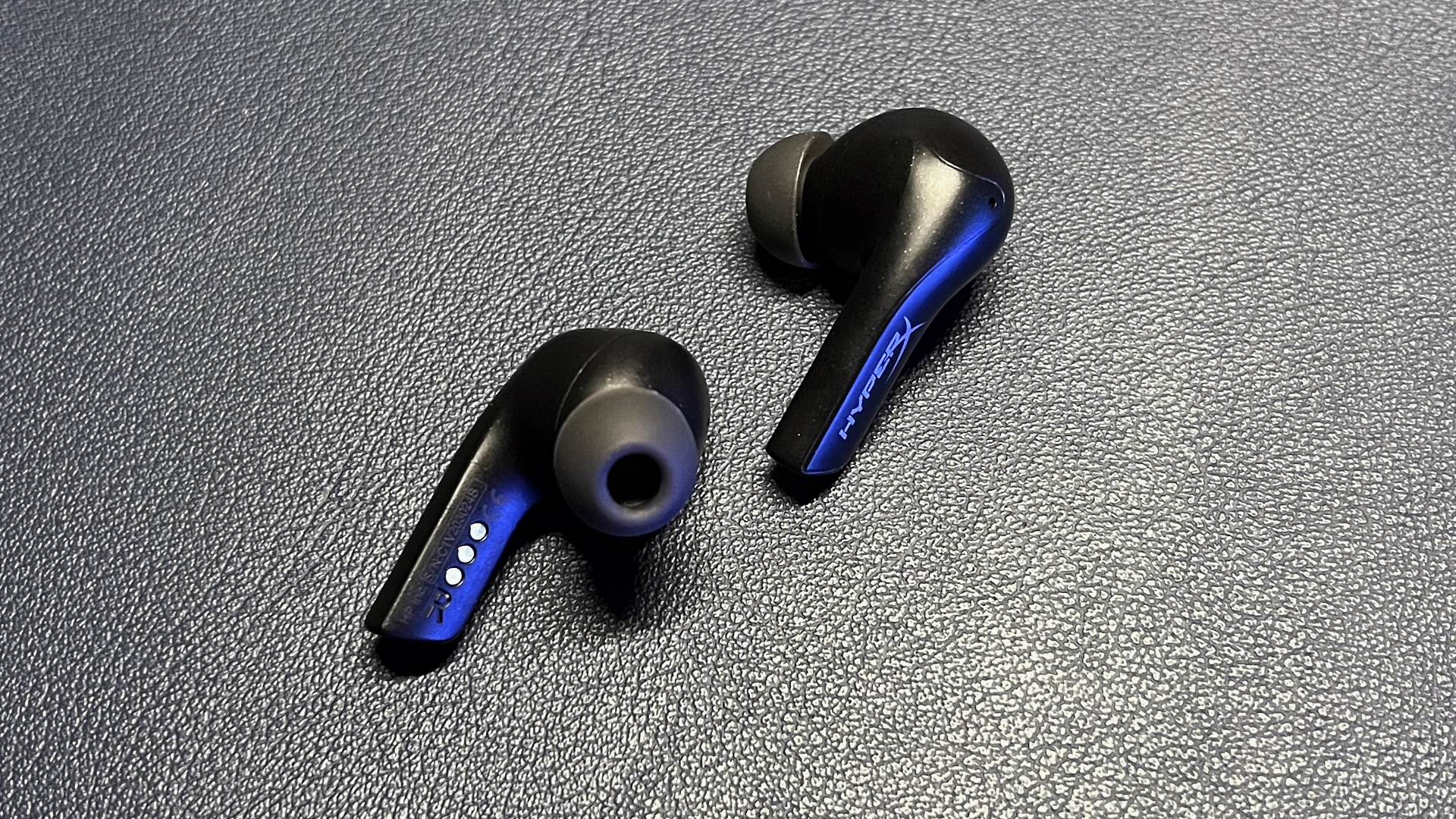
I know how this sounds, but it wasn’t all bad — the earbuds did work as intended some of the time, and when they did the audio quality was pretty good. I was especially impressed with how well they reproduced spatial audio in games (I’ve been playing the new chapter drop in Elder Scrolls Online, so I’ve had plenty of time to walk around cities and consider whether I really feel the atmosphere). They do a very good job with multi-layered sound — for earbuds, and in general.
Music also sounds decent on the Cloud MIX Buds, though earbuds aren’t ever my first choice for music. These earbuds have 12mm drivers — a good size for earbuds — and did a pretty good job of separating mid-range tones while maintaining fullness and warmth. I actually thought these earbuds were a little too warm overall, but at least the bass didn’t end up too muddy or distorted. Audio on the Cloud MIX Buds is pretty good, especially for earbuds — when they’re connected.
The Cloud MIX Buds have omni-directional mics, which are…okay. People were able to hear my voice clearly over video and voice calls, but I’m very loud and my friends pointed out that it didn’t sound nearly as good as when I use a headset with a boom mic. I was also able to take calls on the street without issue, but the mics don’t have any built-in active noise canceling and the people on the other end of the line could definitely hear what was going on around me.
Software for the HyperX Cloud MIX Buds
HyperX’s NGENUITY has been — will be? — updated for the Cloud MIX Buds. The iOS app is available now but I wasn’t able to get the Windows app to update and/or recognize the earbuds. The software isn’t amazing, but it does offer a couple of useful settings and features.
You can customize the Cloud MIX Buds’ touch controls in the NGENUITY app, and set different controls for each earbud. There are maybe too many tap variations — eight variations for each earbud (four general, two for incoming calls, and two for during calls), especially considering that you only get to pick from a small list of multimedia controls. The app also has an equalizer, which is not particularly detailed or robust, and was a little laggy when I used it.
Battery Life on the HyperX Cloud MIX Buds
HyperX claims up to 33 hours of battery life for the Cloud MIX Buds; this is slightly misleading in the way all companies are slightly misleading about the battery life of true wireless earbuds, because it includes the charging case.
The earbuds themselves have a battery life of between six and 10 hours (six hours using the 2.4-GHz wireless connection, 10 hours using Bluetooth), and the charging case adds an extra 15 (2.4-GHz wireless) to 23 (Bluetooth) hours. The earbuds take about two hours to fully charge (the case takes approximately 1.5 hours, and the earbuds and case combined take about four hours).
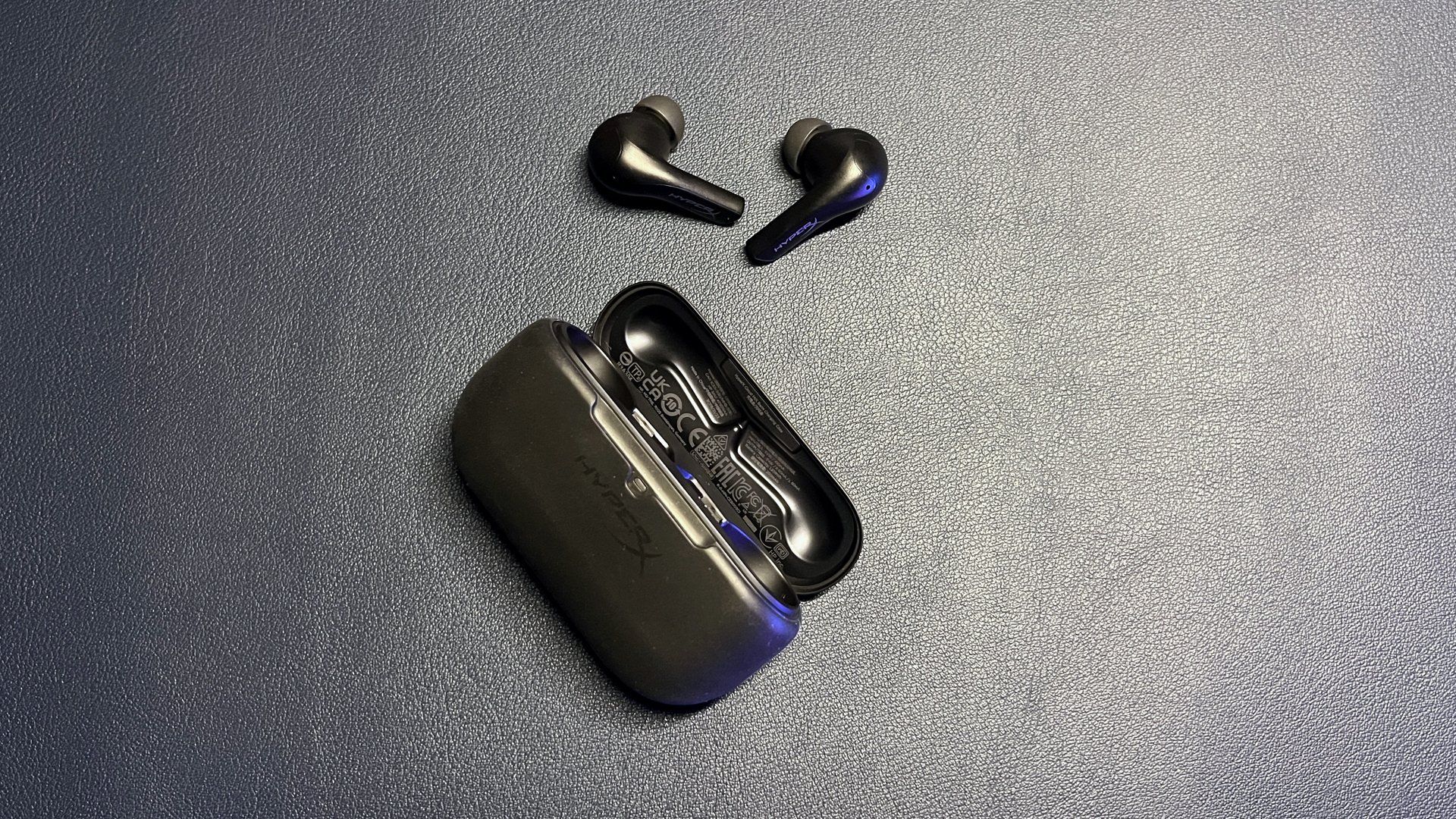
For true wireless earbuds, 10 hours of battery life is pretty good — it’s not exceptional, but it’s on the better side of average. For a gaming headset, six hours using low-latency mode is just so-so. If you’re looking for gaming audio first and headphones/earbuds you can wear on the street second, you may want to consider a headset you can at least use while charging, such as one of the picks on our list of best wireless headsets.
The Bottom Line
The HyperX Cloud MIX Buds have decent battery life for true wireless earbuds, do a good job with multi-layered, spatial audio, and might theoretically make a good pair of dual-use earbuds for gamers on the go. But as of right now, I can’t recommend these given the many, many connection issues I faced. The good news is that most of the connection issues I experienced seem like they could be fixed with a firmware update — but until that happens, I suggest skipping these and picking up one of the best wireless gaming headsets instead.

Sarah Jacobsson Purewal is a senior editor at Tom's Hardware covering peripherals, software, and custom builds. You can find more of her work in PCWorld, Macworld, TechHive, CNET, Gizmodo, Tom's Guide, PC Gamer, Men's Health, Men's Fitness, SHAPE, Cosmopolitan, and just about everywhere else.